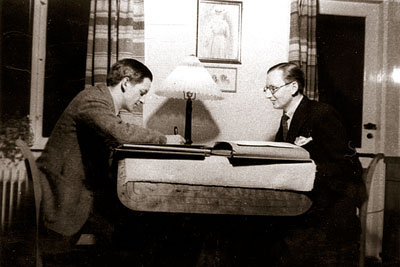Humanities education had begun in the autumn of 1928 with Philosophy, Danish, English, German and French, and during the following years a number of other subjects were added, including History, Classical Philology, Slavonic Studies, and Linguistics, while the Department of Jutland Dialects and Culture was established in 1932.
In 1934, the senior associate professors were promoted to professors with the authority to conduct examinations, and in 1935-36 the first Masters of Arts graduates passed out of the University of Aarhus. From 1936 it was possible to take the degree of magister scientiarium within the faculty, and from 1940 there was the further possibility of defending a thesis for the degree of Doctor of Philosophy.
By the time of the university's 25th Anniversary in 1953, a long list of other subjects had arrived, such as Comparative Literature, Classical Archaeology, Prehistoric Archaeology and Music, and in the following decades the range of subjects was expanded further with Art History, Western Scandinavian Studies, Medieval Archaeology, History of Ideas, and Dramaturgy.
Some subjects were initially introduced in the Faculty of Humanities, but later moved into other faculties as these were established.
In 1973 the faculty's interdisciplinary programme was introduced in the wake of the student unrest and criticism of the single-subject system. Since the 1980's a number of centres within the faculty have seen the light of day, and in the 1990's the subjects of Music, Dramaturgy, Comparative Literature and Art History have been located together with a common library under the title of "The Aesthetic Subjects". Modern Languages were also relocated and furnished with a common library after moving to Nobel Park in 1999.
The Collection of Ancient Art, located under the main building's "Sun Courtyard", has close ties with the faculty, in that it is the result of an expansion of the university's classical archaeology study collection, which was established in 1951, two years after Classical Archaeology had been introduced as a subject.
 Over the years, many renowned academics have been associated with the University of Aarhus, such as Louis Hjelmslev, dr.phil. (1899-1965), who was engaged as a senior associate professor in Comparative Language Studies from 1934 to 1937 and held office as Dean of the Faculty of Humanities from 1935 to 1936. Hjelmslev can be seen here (right), in 1936, in his apartment in Aarhus together with the linguist H J Uldall (1907-1957), with whom he collaborated closely in formulating the Glossematic Theory of Language. (Photographer unknown. University History Committee). |